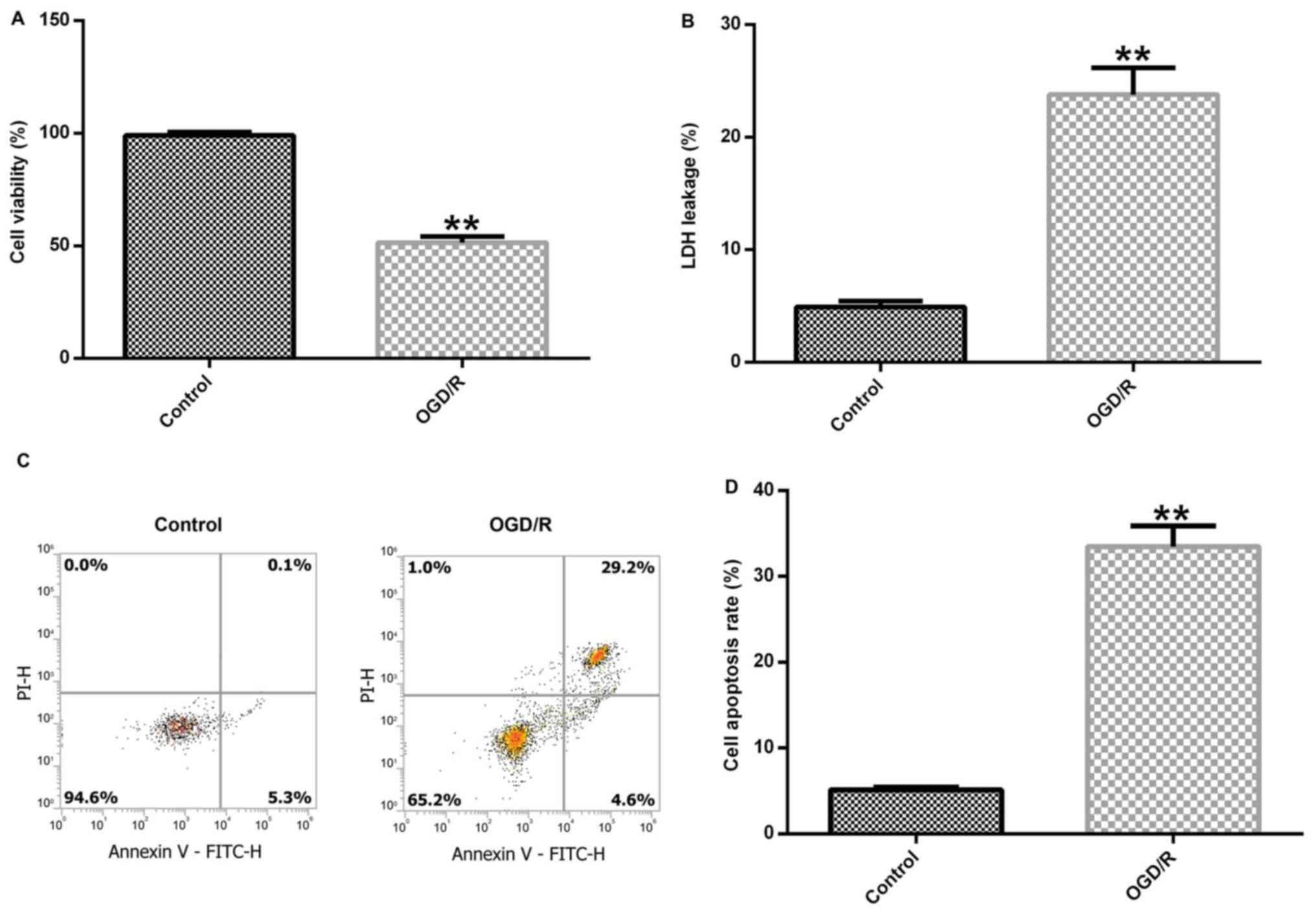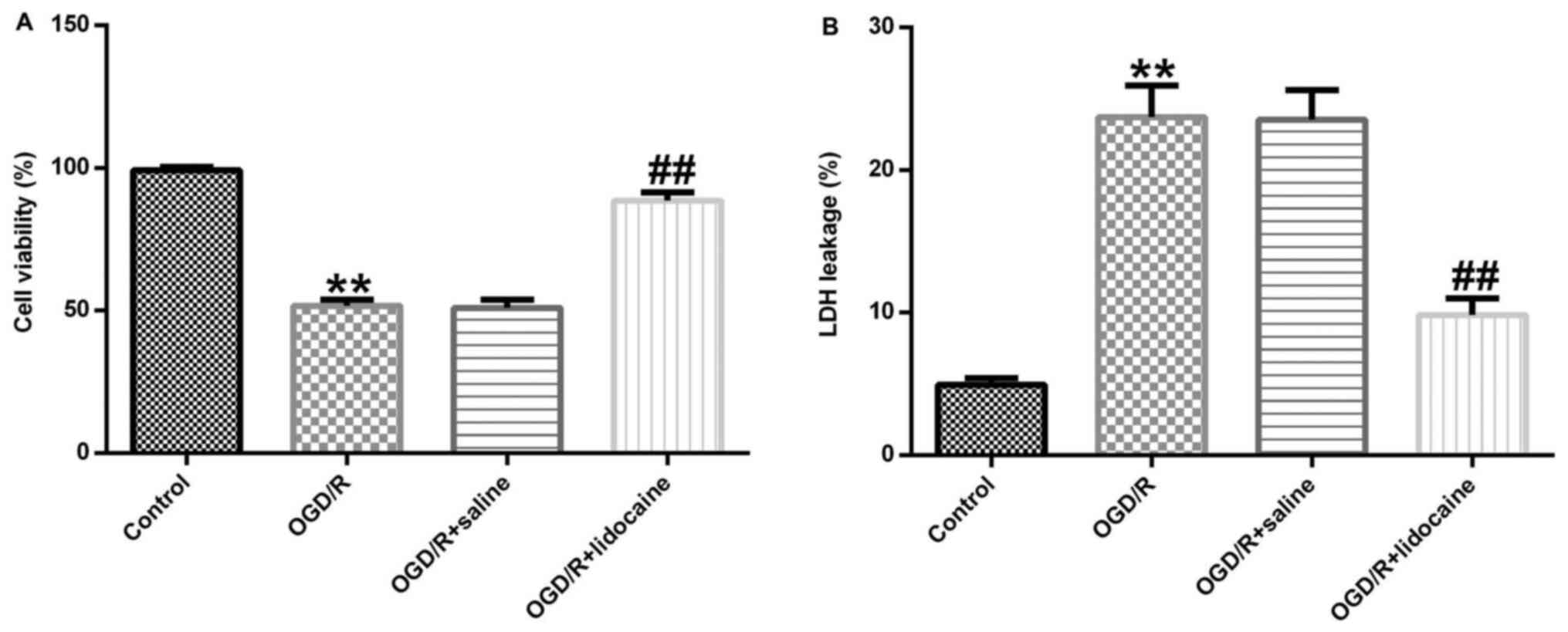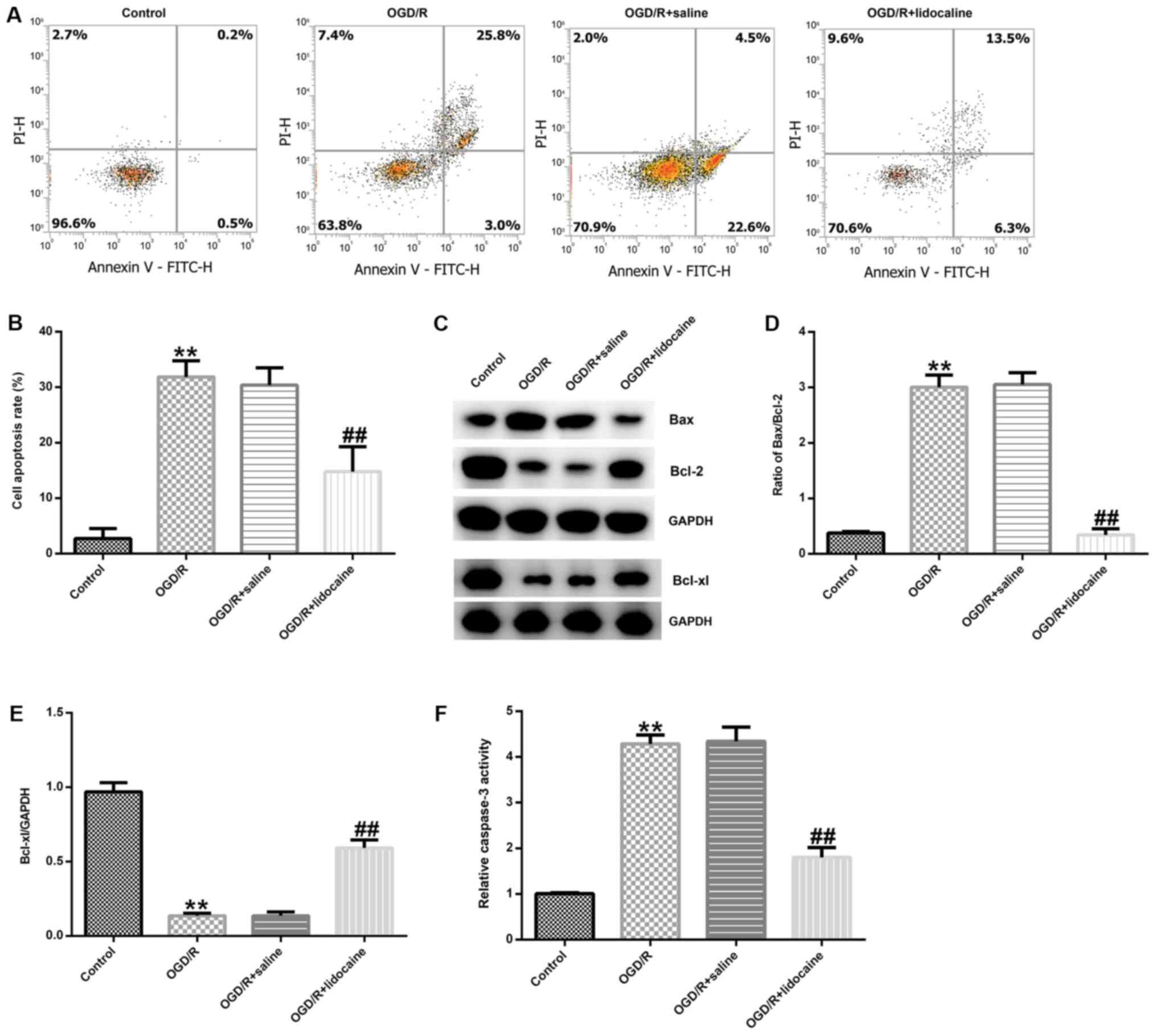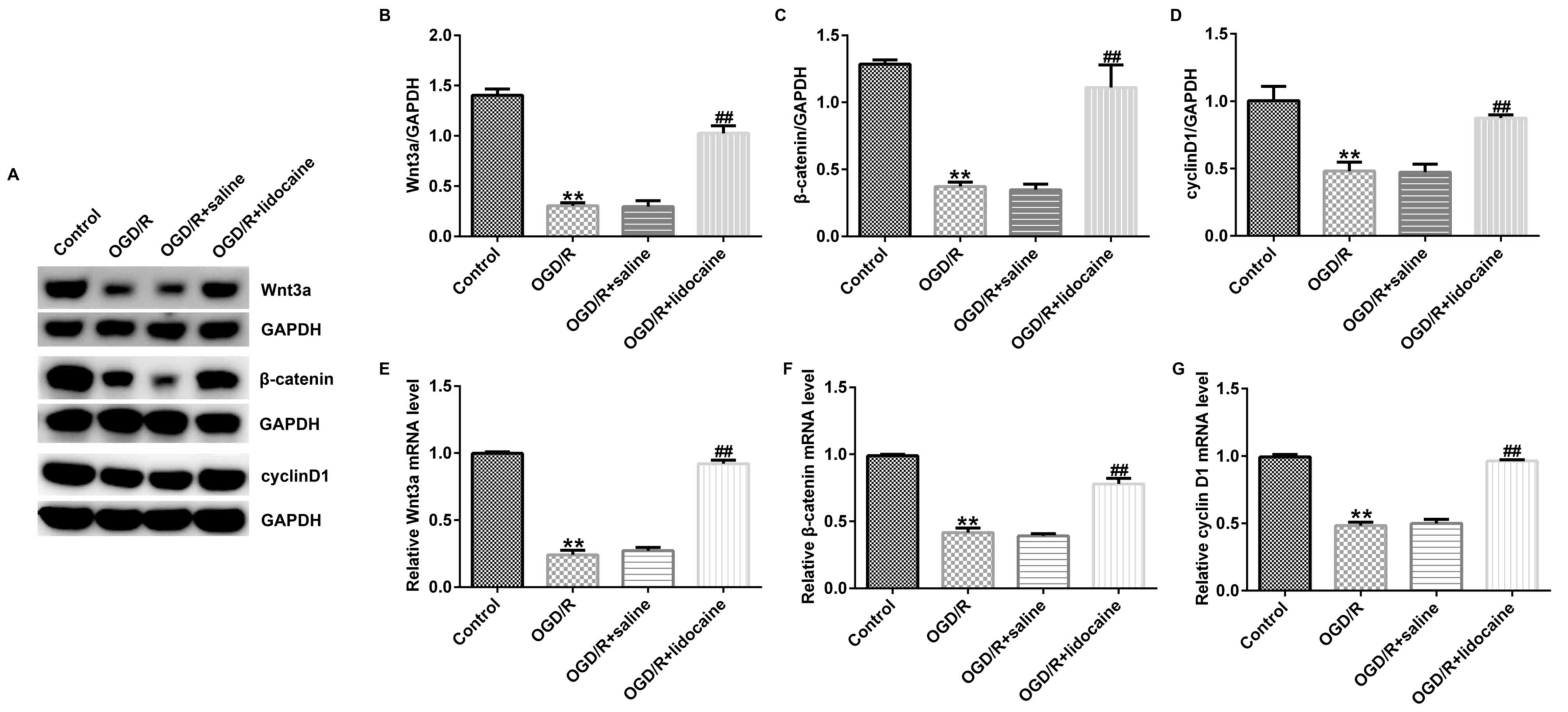|
1
|
Papadakis M and Buchan A: Approaches to
neuroprotective and reperfusion injury therapy. Handb Clin Neurol.
94:1205–1223. 2009.PubMed/NCBI View Article : Google Scholar
|
|
2
|
Zhào H, Liu Y, Zeng J, Li D, Zhang W and
Huang Y: Troxerutin and cerebroprotein hydrolysate injection
protects neurovascular units from oxygen-glucose deprivation and
reoxygenation-induced injury in vitro. Evid Based Complement
Alternat Med. 2018(9859672)2018.PubMed/NCBI View Article : Google Scholar
|
|
3
|
Zhuonan Z, Sen G, Zhipeng J, Maoyou Z,
Linglan Y, Gangping W, Cheng J, Zhongliang M, Tian J, Peijian Z and
Kesen X: Hypoxia preconditioning induced HIF-1alpha promotes
glucose metabolism and protects mitochondria in liver I/R injury.
Clin Res Hepatol Gastroenterol. 39:610–619. 2015.PubMed/NCBI View Article : Google Scholar
|
|
4
|
Yin X, Feng L, Ma D, Yin P, Wang X, Hou S,
Hao Y, Zhang J, Xin M and Feng J: Roles of astrocytic connexin-43,
hemichannels, and gap junctions in oxygen-glucose
deprivation/reperfusion injury induced neuroinflammation and the
possible regulatory mechanisms of salvianolic acid B and
carbenoxolone. J Neuroinflammation. 15(97)2018.PubMed/NCBI View Article : Google Scholar
|
|
5
|
Park SJ, Jung YJ, Kim YA, Lee-Kang JH and
Lee KE: Glucose/oxygen deprivation and reperfusion upregulate
SNAREs and complexin in organotypic hippocampal slice cultures.
Neuropathology. 28:612–620. 2008.PubMed/NCBI View Article : Google Scholar
|
|
6
|
Jung YJ, Park SJ, Park JS and Lee KE:
Glucose/oxygen deprivation induces the alteration of synapsin I and
phosphosynapsin. Brain Res. 996:47–54. 2004.PubMed/NCBI View Article : Google Scholar
|
|
7
|
Wang S, Yin J, Ge M, Dai Z, Li Y, Si J, Ma
K, Li L and Yao S: Transforming growth-beta 1 contributes to
isoflurane postconditioning against cerebral ischemia-reperfusion
injury by regulating the c-Jun N-terminal kinase signaling pathway.
Biomed Pharmacother. 78:280–290. 2016.PubMed/NCBI View Article : Google Scholar
|
|
8
|
Yu W, Gao D, Jin W, Liu S and Qi S:
Propofol prevents oxidative stress by decreasing the ischemic
accumulation of succinate in focal cerebral ischemia-reperfusion
injury. Neurochem Res. 43:420–429. 2018.PubMed/NCBI View Article : Google Scholar
|
|
9
|
Hou Y, Wang J and Feng J: The
neuroprotective effects of curcumin are associated with the
regulation of the reciprocal function between autophagy and
HIF-1alpha in cerebral ischemia-reperfusion injury. Drug Des Devel
Ther. 13:1135–1144. 2019.PubMed/NCBI View Article : Google Scholar
|
|
10
|
Zeng ZW, Zhang YN, Lin WX, Zhang WQ and
Luo R: A meta-analysis of pharmacological neuroprotection in
noncardiac surgery: Focus on statins, lidocaine, ketamine, and
magnesium sulfate. Eur Rev Med Pharmacol Sci. 22:1798–1811.
2018.PubMed/NCBI View Article : Google Scholar
|
|
11
|
Wen X, Xu S, Zhang Q, Li X, Liang H, Yang
C, Wang H and Liu H: Inhibitory gene expression of the Cav3.1
T-type calcium channel to improve neuronal injury induced by
lidocaine hydrochloride. Eur J Pharmacol. 775:43–49.
2016.PubMed/NCBI View Article : Google Scholar
|
|
12
|
Mitchell SJ and Merry AF: Lignocaine:
Neuro-protective or wishful thinking? J Extra Corpor Technol.
41:P37–P42. 2009.PubMed/NCBI
|
|
13
|
Naito H, Takeda Y, Danura T, Kass IS and
Morita K: Effect of lidocaine on dynamic changes in cortical
reduced nicotinamide adenine dinucleotide fluorescence during
transient focal cerebral ischemia in rats. Neuroscience. 235:59–69.
2013.PubMed/NCBI View Article : Google Scholar
|
|
14
|
Zhang Y and Lipton P: Cytosolic
Ca2+ changes during in vitro ischemia in rat hippocampal
slices: Major roles for glutamate and Na+-dependent Ca2+
release from mitochondria. J Neurosci. 19:3307–3315.
1999.PubMed/NCBI View Article : Google Scholar
|
|
15
|
Hsu HC, Tang NY, Liu CH and Hsieh CL:
Antiepileptic effect of Uncaria rhynchophylla and rhynchophylline
involved in the initiation of c-Jun N-terminal kinase
phosphorylation of MAPK signal pathways in acute seizures of kainic
acid-treated rats. Evid Based Complement Alternat Med.
2013(961289)2013.PubMed/NCBI View Article : Google Scholar
|
|
16
|
Zhao P, Yang JM, Wang YS, Hao YJ, Li YX,
Li N, Wang J, Niu Y, Sun T and Yu JQ: Neuroprotection of cytisine
against cerebral ischemia-reperfusion injury in mice by regulating
NR2B-ERK/CREB signal pathway. Neurochem Res. 43:1575–1586.
2018.PubMed/NCBI View Article : Google Scholar
|
|
17
|
Liu X, Zhang X, Zhang J, Kang N, Zhang N,
Wang H, Xue J, Yu J, Yang Y, Cui H, et al: Diosmin protects against
cerebral ischemia/reperfusion injury through activating JAK2/STAT3
signal pathway in mice. Neuroscience. 268:318–327. 2014.PubMed/NCBI View Article : Google Scholar
|
|
18
|
Zhang GX, Ge MY, Han ZW, Wang S, Yin J,
Peng L, Xu F, Zhang Q, Dai Z, Xie L, et al: Wnt/β-catenin signaling
pathway contributes to isoflurane postconditioning against cerebral
ischemia-reperfusion injury and is possibly related to the
transforming growth factorβ1/Smad3 signaling pathway. Biomed
Pharmacother. 110:420–430. 2019.PubMed/NCBI View Article : Google Scholar
|
|
19
|
Anastas JN and Moon RT: WNT signalling
pathways as therapeutic targets in cancer. Nat Rev Cancer.
13:11–26. 2013.PubMed/NCBI View
Article : Google Scholar
|
|
20
|
Chen X, Wang CC, Song SM, Wei SY, Li JS,
Zhao SL and Li B: The administration of erythropoietin attenuates
kidney injury induced by ischemia/reperfusion with increased
activation of Wnt/β-catenin signaling. J Formos Med Assoc.
114:430–437. 2015.PubMed/NCBI View Article : Google Scholar
|
|
21
|
Kuncewitch M, Yang WL, Molmenti E,
Nicastro J, Coppa GF and Wang P: Wnt agonist attenuates liver
injury and improves survival after hepaticischemia/reperfusion.
Shock. 39:3–10. 2013.PubMed/NCBI View Article : Google Scholar
|
|
22
|
He X, Mo Y, Geng W, Shi Y, Zhuang X, Han
K, Dai Q, Jin S and Wang J: Role of Wnt/β-catenin in the tolerance
to focal cerebral ischemia induced by electroacupuncture
pretreatment. Neurochem Int. 97:124–132. 2016.PubMed/NCBI View Article : Google Scholar
|
|
23
|
Tremblay R, Hewitt K, Lesiuk H, Mealing G,
Morley P and Durkin JP: Evidence that brain-derived neurotrophic
factor neuroprotection is linked to its ability to reverse the
NMDA-induced inactivation of protein kinase C in cortical neurons.
J Neurochem. 72:102–111. 1999.PubMed/NCBI View Article : Google Scholar
|
|
24
|
Bayne K: Revised guide for the care and
use of laboratory animals available. American Physiological
Society. Physiologist. 39:199208–199211. 1996.PubMed/NCBI
|
|
25
|
Wu X, Li X, Liu Y, Yuan N, Li C, Kang Z,
Zhang X, Xia Y, Hao Y and Tan Y: Hydrogen exerts neuroprotective
effects on OGD/R damaged neurons in rat hippocampal by protecting
mitochondrial function via regulating mitophagy mediated by
PINK1/Parkin signaling pathway. Brain Res. 1698:89–98.
2018.PubMed/NCBI View Article : Google Scholar
|
|
26
|
Zhang Y, Tao GJ, Hu L, Qu J, Han Y, Zhang
G, Qian Y, Jiang CY and Liu WT: Lidocaine alleviates morphine
tolerance via AMPK-SOCS3-dependent neuroinflammation suppression in
the spinal cord. J Neuroinflammation. 14(211)2017.PubMed/NCBI View Article : Google Scholar
|
|
27
|
Livak KJ and Schmittgen TD: Analysis of
relative gene expression data using real-time quantitative PCR and
the 2(-Delta Delta C(T)) method. Methods. 25:402–408.
2011.PubMed/NCBI View Article : Google Scholar
|
|
28
|
Wang L, Zhang L and Chow BKC: Secretin
prevents apoptosis in the developing cerebellum through Bcl-2 and
Bcl-xL. J Mol Neurosci. 68:494–503. 2019.PubMed/NCBI View Article : Google Scholar
|
|
29
|
Cai Y, Xu H, Yan J, Zhang L and Lu Y:
Molecular targets and mechanism of action of dexmedetomidine in
treatment of ischemia/reperfusion injury. Mol Med Rep. 9:1542–1550.
2014.PubMed/NCBI View Article : Google Scholar
|
|
30
|
Zhang H, Cao HJ, Kimelberg HK and Zhou M:
Volume regulated anion channel currents of rat hippocampal neurons
and their contribution to oxygen-and-glucose deprivation induced
neuronal death. PLoS One. 6(e16803)2011.PubMed/NCBI View Article : Google Scholar
|
|
31
|
Khaspekov L, Friberg H, Halestrap A,
Viktorov I and Wieloch T: Cyclosporin A and its
nonimmunosuppressive analogue N-Me-Val-4-cyclosporin A mitigate
glucose/oxygen deprivation-induced damage to rat cultured
hippocampal neurons. Eur J Neurosci. 11:3194–3198. 1999.PubMed/NCBI View Article : Google Scholar
|
|
32
|
Hou QL, Wang Y, Li YB, Hu XL and Wang SL:
Protective effect of notoginsenoside R1 on neuron injury induced by
OGD/R through ATF6/Akt signaling pathway. Zhongguo Zhong Yao Za
Zhi. 42:1167–1174. 2017.PubMed/NCBI View Article : Google Scholar : (In Chinese).
|
|
33
|
Wei R, Zhang R, Li H, Li H, Zhang S, Xie
Y, Shen L and Chen F: MiR-29 Targets PUMA to suppress oxygen and
glucose deprivation/reperfusion (OGD/R)-induced cell death in
hippocampal neurons. Curr Neurovasc Res. 15:47–54. 2018.PubMed/NCBI View Article : Google Scholar
|
|
34
|
Tian X, An R, Luo Y, Li M, Xu L and Dong
Z: Tamibarotene improves hippocampus injury induced by focal
cerebral ischemia-reperfusion via modulating PI3K/Akt pathway in
rats. J Stroke Cerebrovasc Dis. 28:1832–1840. 2019.PubMed/NCBI View Article : Google Scholar
|
|
35
|
Zhang HY, Song YM and Feng C: Improvement
of cerebral ischemia/reperfusion injury by daucosterol
palmitate-induced neuronal apoptosis inhibition via PI3K/Akt/mTOR
signaling pathway. Metab Brain Dis: May 4, 2020 (Epub ahead of
print).
|
|
36
|
Zhang Y, Geng J, Hong Y, Jiao L, Li S, Sun
R, Xie Y, Yan C, Aa J and Wang G: Orally administered crocin
protects against cerebral ischemia/reperfusion injury through the
metabolic transformation of crocetin by gut microbiota. Front
Pharmacol. 10(440)2019.PubMed/NCBI View Article : Google Scholar
|
|
37
|
Seyfried FJ, Adachi N and Arai T:
Suppression of energy requirement by lidocaine in the ischemic
mouse brain. J Neurosurg Anesthesiol. 17:75–81. 2005.PubMed/NCBI View Article : Google Scholar
|
|
38
|
Zheng X, Chen L, Du X, Cai J, Yu S, Wang
H, Xu G and Luo Z: Effects of hyperbaric factors on
lidocaine-induced apoptosis in spinal neurons and the role of p38
mitogen-activated protein kinase in rats with diabetic neuropathic
pain. Exp Ther Med. 13:2855–2861. 2017.PubMed/NCBI View Article : Google Scholar
|
|
39
|
Wu J, Yang J, Liu Q, Wu S, Ma H and Cai Y:
Lanthanum induced primary neuronal apoptosis through mitochondrial
dysfunction modulated by Ca2+ and Bcl-2 family. Biol
Trace Elem Res. 152:125–134. 2013.PubMed/NCBI View Article : Google Scholar
|
|
40
|
Ghosh AP, Walls KC, Klocke BJ, Toms R,
Strasser A and Roth KA: The proapoptotic BH3-only, Bcl-2 family
member, Puma is critical for acute ethanol-induced neuronal
apoptosis. J Neuropathol Exp Neurol. 68:747–756. 2009.PubMed/NCBI View Article : Google Scholar
|
|
41
|
Khodapasand E, Jafarzadeh N, Farrokhi F,
Kamalidehghan B and Houshmand M: Is Bax/Bcl-2 ratio considered as a
prognostic marker with age and tumor location in colorectal cancer?
Iran Biomed J. 19:69–75. 2015.PubMed/NCBI View Article : Google Scholar
|
|
42
|
Jin Z, Ke J, Guo P, Wang Y and Wu H:
Quercetin improves blood-brain barrier dysfunction in rats with
cerebral ischemia reperfusion via Wnt signaling pathway. Am J
Transl Res. 11:4683–4695. 2019.PubMed/NCBI
|


















